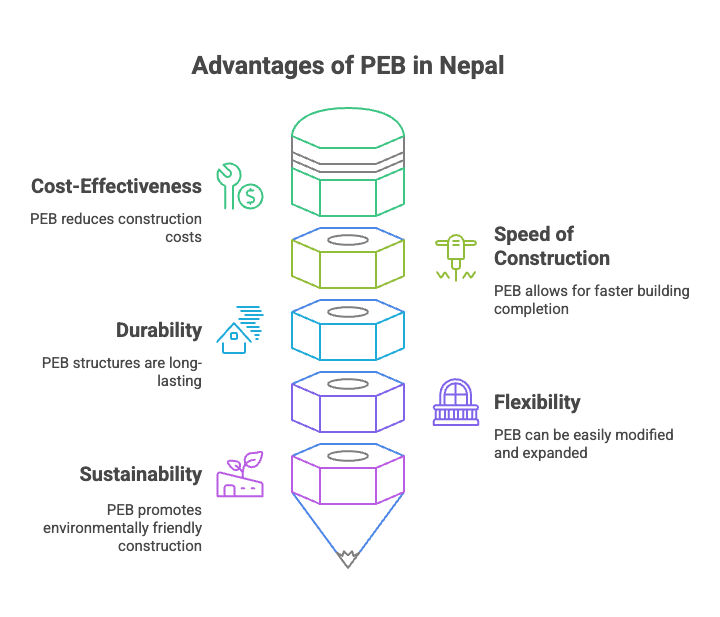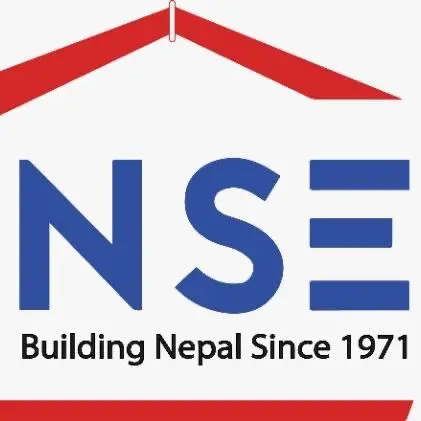
Top 5 Benefits of PEB Structures for Industrial Projects in Nepal
Nepal’s industrial landscape is booming, with sectors like manufacturing, logistics, and warehousing driving demand for modern construction solutions. Traditional methods, reliant on labor-intensive processes, often fall short in meeting the fast-paced, budget-conscious, and environmentally aware demands of today’s industries.
Pre-Engineered Buildings (PEBs) offer a revolutionary alternative, delivering unmatched benefits of PEB structures. This article dives into the top 5 benefits of PEB for industrial projects in Nepal, supported by examples and research to illustrate their transformative impact.
1. Speedy Construction: Accelerating Industrial Growth
One of the standout benefits of PEB is their remarkable construction speed. In Nepal, where industrial projects demand rapid operational readiness, PEBs provide a significant advantage over traditional methods.
How PEBs Save Time
PEBs are designed and fabricated in controlled factory environments, with components like steel beams, columns, and panels pre-cut and pre-drilled for assembly. On-site, these components are simply bolted together, reducing construction time dramatically. According to a 2023 study by the Nepal Construction Industry Association, PEB projects are completed 40-50% faster than traditional construction projects. For instance, a 10,000-square-foot warehouse in Biratnagar, built using PEB technology, was completed in just 10 weeks, compared to 6-8 months for a similar project using traditional methods.

Why It Matters in Nepal
In Nepal’s competitive industrial sector, delays can lead to lost revenue. For example, a logistics company in Bharatpur needed a warehouse operational within three months to meet a new contract. By leveraging the benefits of PEB, the company completed the project in 9 weeks, enabling early operations and significant cost savings.
Comparison Table: Construction Speed
| Aspect | PEB Structures | Traditional Construction |
|---|---|---|
| Construction Time | 8-12 weeks for a warehouse | 6-8 months for a warehouse |
| Assembly Process | Bolt-together, minimal on-site work | Labor-intensive, on-site masonry |
| Weather Impact | Minimal, factory-based | High, delays from monsoons |
Verdict: The benefits of PEB in terms of speed make them ideal for Nepal’s time-sensitive industrial projects, ensuring businesses can start operations sooner.
2. Cost-Effectiveness: Maximizing Budget Efficiency
Another key benefit of PEB is cost-effectiveness, crucial for Nepal’s industries operating under tight budgets. PEBs reduce expenses without compromising quality, making them a smart investment.
How PEBs Save Money
PEBs achieve cost savings through:
- Minimal Material Wastage: Factory precision ensures exact material use, reducing waste by up to 20%, as per a 2024 report by the Asian Construction Research Institute.
- Lower Labor Costs: PEB assembly requires fewer workers due to pre-fabricated components, cutting labor expenses by 15-25%.
- Optimized Design: Standardized components reduce material costs while maintaining structural integrity.
For example, a manufacturing facility in Butwal adopted PEBs for a new factory, saving 30% on construction costs compared to a traditional concrete structure. These savings allowed the company to invest in advanced machinery, boosting productivity.
Nepal’s Context
In Nepal, where transportation costs for raw materials can be high due to challenging terrain, the benefits of PEB shine. PEBs require fewer raw materials and less on-site work, reducing logistical expenses. A case study from a Kathmandu-based cold storage project showed that PEBs cut overall costs by 25%, enabling the company to allocate funds to energy-efficient cooling systems.
Comparison Table: Cost Efficiency
| Aspect | PEB Structures | Traditional Construction |
|---|---|---|
| Material Wastage | 5-10%, factory-controlled | 20-30%, on-site errors |
| Labor Costs | 15-25% lower | Higher, labor-intensive |
| Total Cost Savings | 20-30% cheaper | More expensive, longer timelines |
Verdict: The benefits of PEB in cost-effectiveness make them a game-changer for Nepal’s budget-conscious industrial projects.
3. Durability and Strength: Built for Nepal’s Challenges
Nepal’s seismic activity and extreme weather conditions demand robust construction. The benefits of PEB include exceptional durability and strength, tailored to Nepal’s unique challenges.
PEBs and Durability
PEBs are constructed using high-quality steel, designed to withstand earthquakes, a critical factor in Nepal’s seismic zones. According to a 2022 study by the Nepal Earthquake Engineering Research Center, PEBs exhibit superior seismic performance due to their lightweight yet strong design. Additionally, PEBs are corrosion-resistant, ensuring longevity in Nepal’s monsoon-heavy climate and high-altitude regions.
Real-World Example
A factory in Pokhara, located in a seismic-prone area, was built using PEBs in 2021. During a minor tremor in 2023, the structure sustained no damage, while nearby traditional buildings required repairs. This resilience highlights the benefits of PEB in ensuring safety and operational continuity.
Comparison Table: Durability
| Aspect | PEB Structures | Traditional Construction |
|---|---|---|
| Earthquake Resistance | High, lightweight steel | Moderate, needs reinforcement |
| Weather Resistance | Corrosion-resistant, durable | Prone to water damage |
| Maintenance | Low, 30-50 year lifespan | High, frequent repairs |
Verdict: The benefits of PEB in durability make them a reliable choice for Nepal’s industrial projects facing environmental and seismic challenges.
4. Flexibility in Design and Expansion: Adapting to Growth
Flexibility is a critical benefit of PEB for Nepal’s dynamic industries, which often require tailored designs and scalability to accommodate growth.
PEBs and Flexibility
PEBs offer modular designs, allowing businesses to customize layouts for specific needs, such as machinery placement or storage optimization. Their bolt-together construction enables easy expansion without disrupting operations. For instance, a warehousing company in Hetauda used a PEB structure to start with a 5,000-square-foot facility and later expanded it by 50% in just 4 weeks, a process that would have taken months with traditional construction.
Industry Impact
Nepal’s manufacturing and logistics sectors are expanding rapidly, with a 2024 report from the Federation of Nepalese Chambers of Commerce and Industry noting a 15% annual growth in industrial infrastructure demand. The benefits of PEB in flexibility allow businesses to scale efficiently, ensuring they remain competitive.
Comparison Table: Flexibility
| Aspect | PEB Structures | Traditional Construction |
|---|---|---|
| Design Customization | High, modular layouts | Limited, rigid designs |
| Expansion Ease | Easy, bolt-on additions | Difficult, major reconstruction |
| Time for Expansion | 4-6 weeks | 3-6 months |
Verdict: The benefits of PEB in flexibility cater to Nepal’s growing industries, offering adaptable and scalable solutions.
5. Sustainability: Building a Greener Nepal
Sustainability is a global and local priority, and the benefits of PEB align with eco-friendly construction practices, supporting Nepal’s commitment to the UN’s Sustainable Development Goals (SDGs).
PEBs and Sustainability
PEBs promote sustainability through:
- Recyclable Materials: Steel is 100% recyclable, reducing resource depletion.
- Low Waste: Factory fabrication generates 10-15% less waste than traditional methods, per a 2023 environmental study by the Nepal Green Building Council.
- Energy Efficiency: PEBs use less energy during construction and can incorporate insulation for reduced operational energy consumption.
For example, a cold storage facility in Nepalgunj used PEBs with insulated panels, cutting energy costs by 20% and reducing its carbon footprint. This aligns with Nepal’s push for greener construction practices.
Comparison Table: Sustainability
| Aspect | PEB Structures | Traditional Construction |
|---|---|---|
| Material Usage | Recyclable steel | High-use concrete, non-recyclable |
| Construction Waste | 10-15% less | Higher, on |
Conclusion
With benefits like speed, cost savings, durability, and sustainability, it’s no surprise that PEB structures are revolutionizing Nepal’s industrial construction landscape. From warehouses and factories to cold storage and logistics hubs, PEBs cater to diverse industrial needs.
The advantages of using PEB structures for industrial projects in Nepal are clear. They save time, reduce costs, and ensure long-term durability while supporting sustainable practices. If you’re planning an industrial project, choosing PEB structures could be the smartest investment you make.
Recommended reading: Why Pre-Engineered Buildings Are the Future of Construction in Nepal



